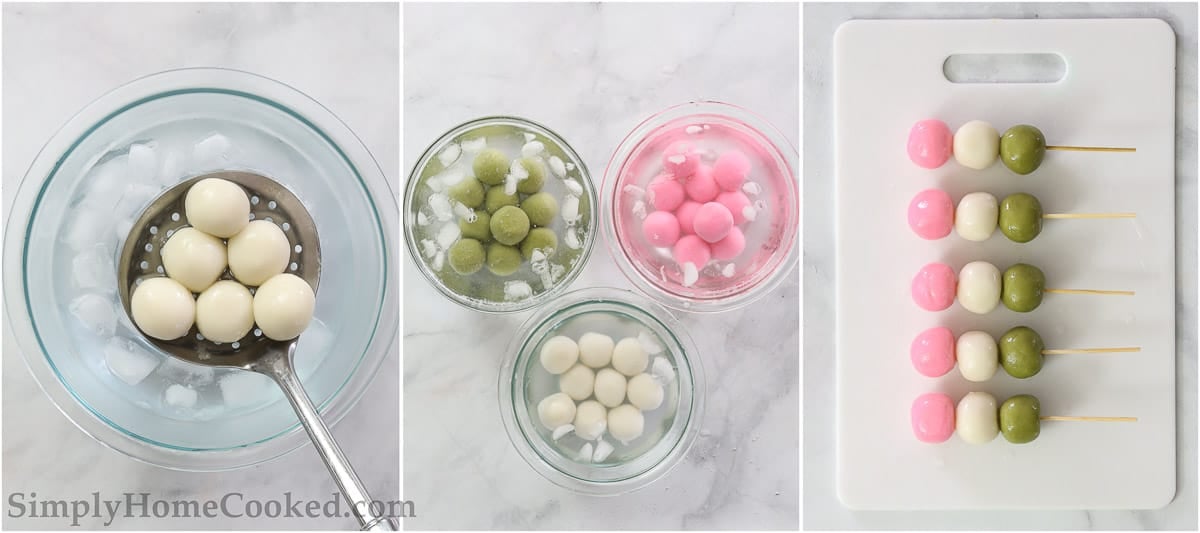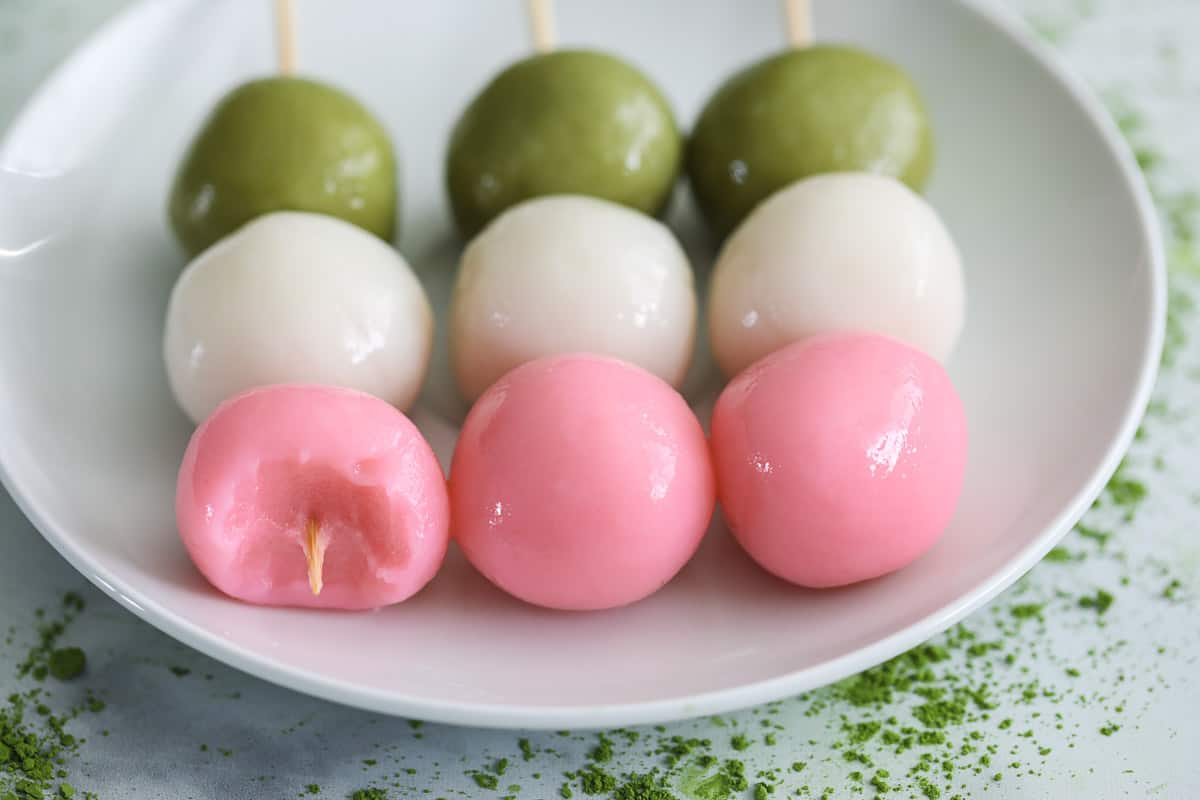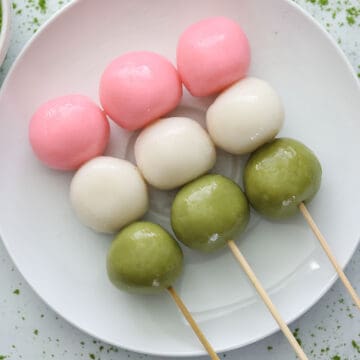With spring in the air, you have got to try this Easy Hanami Dango recipe. Firm, colorful rice balls that are sweet and chewy, this Japanese treat is a must this season.
If you like Asian desserts, you should try these yummy mochi donuts and sweet ube ice cream.

Table Of Contents
Why this Dango recipe is so easy
This Hanami Dango recipe only uses a few ingredients and is really easy to follow. Chewy, tender, but still firm, these rice balls are a sweet treat made with rice flour, and brightly colored with pink food coloring and green matcha powder. This dessert is perfect when paired with some Mochi Donuts (VIDEO) or following a savory meal of Hibachi Fried Rice Recipe or Crispy Shrimp Tempura. Enjoy the sweet pink and white balls, as well as the mildly earthy green ones, in this skewered Japanese treat.
What is hanami dango?
Hanami dango is a year round dessert that is enjoyed most commonly during the cherry blossom viewing season in Japan. This coincides with the beginning of spring, and the three colors are said to symbolize the pink of the spring cherry blossoms, the white of the winter snow, and the green of the summer grass. They are made with sweet rice flour and are bright, chewy, soft, and delicious.
What you’ll need
- Joshinko glutinous rice flour– The Dango base
- Shiratamako glutinous sweet rice flour– The Dango base and also to add sweetness
- Powdered sugar- this is optional but recommended.
- Hot water– This creates the dough to form the dango
- Matcha powder– For flavor and color
- Pink food coloring– For color. Use the gel kind.

How to Make Hanami Dango
- Soak the skewers. First, soak the 12 bamboo skewers in water.
- Mix the rice flour and water. Place the rice flours into a bowl and then pour in the hot water. Begin mixing with a spoon, and then when it starts to take shape, use your hands to mold the dango dough together. Add a little more flour or water if needed. The dough should feel like clay or play-doh, but softer.
- Divide the dough. Evenly divide the dango dough into three pieces. Place each one into a separate bowl.
- Color the pink dough. Add 1 drop of pink food coloring to one piece of dough and work it in until there is no more white.
- Color the green dough. Now add 1 teaspoon of water to the matcha powder and mix to make a paste. Then add it to another piece of dough and work it in well. The last piece of dough should remain white.

- Shape the dough into balls. Begin shaping the dough into balls. Each ball should be 20 grams, weighed on a kitchen scale. The recipe makes about 36 balls.
- Cook the white dango balls. Bring a pot of water to a boil and begin cooking the white balls first. Once they rise to the top of the pot, continue cooking them for another 2 minutes.

- Cool the dango balls. Once cooked, use a slotted spoon to transfer the steamed dango to a bowl of ice water.
- Repeat with the pink and green balls. Continue this process with the pink and then the green dango to avoid staining the water.
- Skewer the dango. Place the balls on the bamboo skewers, making sure to place the green ones on first, then the white, and the pink ones last. Serve as they are or add a topping.

Tips for the best Hanami Dango
- Soak the skewers first– This step is important because it will make it easier to slide the dango balls onto the skewer later.
- Measure with a kitchen scale- For accuracy, measure the flour on a kitchen scale. This will help you get the right texture for your dango dough because it will be more exact. Also, you can measure your dough balls so they are equal in size.
- Soften the dango with tofu- If you prefer a softer texture, you can substitute the water in this recipe with silken tofu. Just make sure the texture remains similar to a soft play-doh.
- Only add one drop of food coloring- The color of the hanami dango will intensify as it cooks, so try not to add more than a drop of pink food coloring or too much matcha, unless you want them to be very, very bright.
- Cook them in the right order– Start with the white, then the pink, and then the green last, lightest to darkest. This is so the colors don’t stain the water and change the color of the dango.

Dango vs. Mochi: What’s the difference
Mochi and dango are not the same. Though they have a similar mild flavor and both are white, their texture is different. Mochi is made with glutinous rice, while dango is made with rice flour. This is an important difference and one cannot be substituted for the other.
Tasty toppings for Dango
These delicious hanami dango can be eaten just as they are, but are also tasty with a topping of sweet soy glaze, red bean paste, or matcha paste. Try each one out to see which you like best!
What to Serve it with
There are tons of delicious dishes that would be perfect before a dessert of hanami dango. You could start with a Shrimp Tempura Roll and Dipping Sauce, or Fried Spring Rolls (VIDEO) with some Yum Yum Sauce. If you prefer soup, this flavorful Shrimp Tempura Udon Soup is wonderful. Also, 30-Minute Shrimp Chow Mein, Grilled Teriyaki Chicken, and Garlic Ginger Shrimp (VIDEO) are great choices. And don’t forget the Ube ice cream!

How to Store Dango
You can store this easy Hanami Dango in an airtight container at room temperature for up to 2 days. A cool place to store it is fine, but avoid the refrigerator because it will make the dango tough.
More tasty Asian dishes to enjoy!
- The BEST Mochi Donuts Recipe (VIDEO)
- Hibachi Fried Rice Recipe
- Ube Ice Cream
- Panko Crusted Salmon
- Shrimp Tempura Roll Recipe

Full Recipe Instructions

Easy Dango Recipe
Ingredients
- 1 1/3 cup Joshinko non-glutinous rice flour (1 1/3 cup ) 150 g
- 1 1/2 cup shiratamako glutinous sweet rice flour (1 1/2 cup) 200 g
- 3/4 cup powdered sugar (optinal) to make it sweeter 75 g
- 1 1/3 cup hot water
- 1 teaspoon matcha powder + 1 tsp water
- 1 drop pink food coloring
Instructions
- Before you get started on the dango, you’ll need to soak 12 small bamboo skewers in water.
- Add 150 grams of non-glutinous rice flour (joshinko) into a bowl, along with 200 grams glutinous sweet rice flour (shiratamako). You can also add 75 grams of powdered sugar to make the dango sweeter if you want.
- Then pour in 1 1/3 cup hot water. Begin mixing using a spoon. Once the mixture begins to take shape, use your hands to mold the dango dough together. Depending on how you measured your ingredients can determine the texture of the dough. So you may need to add a little more flour or a little more water to get the correct consistency. The dough should feel similar to clay or play-dough, but a little softer.
- Now, evenly divide the dough into three separate pieces. Place the dough pieces into 3 separate bowls. Add 1 drop of pink food coloring into one piece and work it in.
- The second piece of dough will be the matcha one. So you’ll need to add 1 teaspoon of water to 1 teaspoon of match powder to make a paste. Then add the Matcha paste to that dough and work it in as well.
- The third piece of dough will remain white, so you do not need to add anything to it.
- Now shape the dough into round balls. Each ball should be 20 grams. It’s best to use a kitchen scale when measuring out the weight of the dough. This recipe should make about 36 balls.
- Now bring a pot of water to a boil and begin cooking the white dango balls first. Once you see the balls rise to the top of the pot, continue cooking for another 2 minutes.
- Then use a slotted spoon to transfer the steamed dango and quickly place it into a bowl of ice water.
- Continue doing this for the pink dango and then the green dango last. You want to cook in this order to avoid staining the water and changing the color of the dango.
- Now you can skewer the dango onto the bamboo skewers. Always insert the green ones first, then the white ones in the middle, and the pink ones last. The pink symbolizes spring cherry blossoms, white represents winter snow, and green represents summer grass. They are typically eaten during spring cherry blossom season. You can eat them as they are or add toppings like sweet soy glaze, red bean paste, or matcha paste.
Notes
- Soak the skewers first– This step is important because it will make it easier to slide the dango balls onto the skewer later.
- Measure with a kitchen scale- For accuracy, measure the flour on a kitchen scale. This will help you get the right texture for your dango dough because it will be more exact. Also, you can measure your dough balls so they are equal in size.
- Soften the dango with tofu- If you prefer a softer texture, you can substitute the water in this recipe with silken tofu. Just make sure the texture remains similar to a soft play-doh.
- Only add one drop of food coloring- The color of the hanami dango will intensify as it cooks, so try not to add more than a drop of pink food coloring or too much matcha, unless you want them to be very, very bright.
- Cook them in the right order– Start with the white, then the pink, and then the green last, lightest to darkest. This is so the colors don’t stain the water and change the color of the dango.
Nutrition
- Creamed Corn - October 9, 2024
- Baked Plantain Chips - October 7, 2024
- Chicken Meatball Soup - October 2, 2024


Lorelai says
It was really nice to cook, and it tasted nice with a soy sauce sugar blend.
Dina says
I am so glad you loved this recipe Lorelai!
Lori says
Hi Dina,
I wanted to know what do you use to make the balls all the same round size?
Dina says
Hi Lori, I use a kitchen scale to weigh each ball. Each should be 20 grams. The recipe will make about 36 balls.